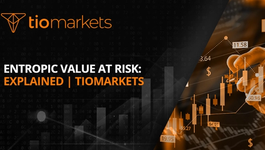Mining vs. Staking: Which Crypto Earning Strategy is Right for You?
BY TIOmarkets
|May 24, 2024Cryptocurrency has become a popular investment option in recent years, with individuals exploring various ways to earn from it. Two common strategies for earning in the crypto world are mining and staking. In this article, we will delve into the intricacies of these strategies, their benefits and drawbacks, and help you determine which one is right for you.
Understanding Cryptocurrency Earning Strategies
Cryptocurrency is a digital or virtual form of currency that relies on cryptography for secure transactions and to control the creation of new units. Unlike traditional fiat currencies, cryptocurrencies operate independently of central banks and are decentralized. This decentralized nature allows individuals to earn cryptocurrencies in different ways, such as through mining and staking.
The Basics of Cryptocurrency
Before diving into mining and staking, it's important to grasp the fundamentals of cryptocurrency. Cryptocurrencies are built on blockchain technology, which is a distributed ledger that records all transactions across a network of computers. This decentralized ledger ensures transparency and security.
Blockchain technology, the backbone of cryptocurrencies, is a revolutionary concept that enables peer-to-peer transactions without the need for intermediaries. Each block in the blockchain contains a list of transactions, and once a block is added to the chain, it is immutable, making it highly secure against tampering.
The Importance of Earning Strategies
With the rising popularity of cryptocurrencies, having a well-defined earning strategy is crucial. While some individuals invest in cryptocurrencies purely for speculative purposes, others see the potential for earning additional coins through mining or staking.
It's essential to understand the risks and rewards associated with different earning strategies in the cryptocurrency space. Mining, the process of validating transactions and adding them to the blockchain, requires significant computational power and energy consumption. On the other hand, staking involves holding funds in a cryptocurrency wallet to support the network's operations and earn rewards in return.
The Mechanism of Crypto Mining
Mining is the process of validating transactions and creating new cryptocurrency coins. In the case of mining, powerful computers perform complex calculations to solve mathematical puzzles. Once a puzzle is solved, a new block is added to the blockchain, and the miner is rewarded with cryptocurrency.
Furthermore, the process of crypto mining is not only about solving mathematical puzzles but also about maintaining the security and integrity of the blockchain network. Miners play a crucial role in ensuring that transactions are legitimate and that the decentralized nature of cryptocurrencies is preserved.
What is Crypto Mining?
Crypto mining involves using specialized hardware, called mining rigs, to perform the necessary calculations for validating transactions. Miners compete with each other to solve these puzzles, and the first miner to find a solution is rewarded.
Moreover, the complexity of mining algorithms is designed to increase over time, ensuring a steady flow of new coins into circulation while also preventing malicious actors from manipulating the system. This intricate balance of competition and security is what underpins the decentralized nature of cryptocurrencies.
Pros and Cons of Crypto Mining
There are several advantages to crypto mining. Firstly, mining allows individuals to earn newly minted coins, which can be a lucrative investment. Additionally, mining can provide a steady stream of income, especially in the case of popular cryptocurrencies. However, mining can also be resource-intensive and require substantial upfront investment in hardware and electricity costs.
On the other hand, the decentralized nature of crypto mining means that it is not controlled by any central authority, offering individuals a level of financial independence and autonomy. This aspect of mining has attracted a diverse range of participants, from hobbyists to large-scale mining operations, contributing to the widespread adoption of cryptocurrencies.
The Impact of Crypto Mining on the Environment
A drawback to crypto mining is its environmental impact. The energy consumption associated with mining processes has raised concerns about carbon footprints. However, efforts are being made to develop more energy-efficient mining methods, such as using renewable energy sources.
Furthermore, the environmental impact of crypto mining has sparked discussions around the concept of "green mining," which focuses on reducing energy consumption and carbon emissions through innovative technologies and sustainable practices. By addressing these environmental challenges, the crypto mining industry aims to strike a balance between technological advancement and environmental responsibility.
The Process of Crypto Staking
Crypto staking, on the other hand, is a relatively newer concept that involves individuals holding and validating transactions within a proof-of-stake (PoS) blockchain network. Rather than using computational power, stakers are chosen to create new blocks based on the number of coins they hold and are willing to "stake" as collateral.
When a staker decides to participate in crypto staking, they essentially lock up a certain amount of their chosen cryptocurrency in a designated wallet. This process helps secure the network and allows stakers to earn rewards for their contribution to maintaining the blockchain.
What is Crypto Staking?
Crypto staking involves locking up a certain amount of cryptocurrency in a wallet and participating in the network's consensus mechanism. By holding and staking coins, stakers help maintain the overall security and smooth operation of the network.
It's important to note that the staked coins are not actually transferred anywhere; they remain in the staker's possession at all times. The act of staking simply involves making them temporarily unusable for trading or other transactions while they are being used to validate blocks.
Pros and Cons of Crypto Staking
Staking offers several advantages, including the ability to earn a passive income by simply holding coins. Staking also requires less electricity and specialized hardware compared to mining, making it an environmentally friendly alternative. However, staking does require individuals to lock up their coins, which can limit their liquidity and potential for other investments.
On the flip side, one of the significant benefits of staking is the potential for higher returns compared to traditional savings accounts or other investment options. Additionally, staking rewards are often distributed regularly, providing stakers with a predictable income stream over time.
The Role of Crypto Staking in Blockchain Networks
Staking plays a vital role in the consensus mechanism of blockchain networks. By staking coins, individuals actively contribute to the security and decentralization of the network, helping ensure its integrity and efficiency.
Moreover, the process of staking encourages long-term commitment and participation in the blockchain ecosystem. Stakers who are financially invested in the network are more likely to act in its best interests, further strengthening the overall trust and reliability of the system.
Comparing Mining and Staking
While both mining and staking offer avenues for earning cryptocurrencies, they differ in several aspects.
Differences Between Mining and Staking
One significant difference is the method used to validate transactions and create new blocks. Mining relies on computational power, while staking relies on the amount of coins held and staked. Additionally, mining usually requires expensive hardware, whereas staking can be done with a standard computer or even a mobile device.
Similarities Between Mining and Staking
Both mining and staking contribute to the security and decentralization of blockchain networks. They also offer individuals the opportunity to earn cryptocurrencies. Furthermore, both strategies require individuals to actively engage with the crypto world and stay informed about the market trends.
Evaluating Profitability: Mining vs Staking
When it comes to profitability, several factors need to be considered, such as the cost of hardware, electricity consumption, the price volatility of the cryptocurrency being mined or staked, and the overall network rewards. It's essential to conduct thorough research and evaluate these factors before deciding on a particular strategy.
In conclusion, both mining and staking offer distinct ways to earn cryptocurrencies. Mining requires powerful hardware and consumes significant electricity, while staking provides a more accessible and environmentally friendly option. Consider your budget, technical capabilities, and long-term goals when determining the right strategy for you. Remember, cryptocurrency markets are dynamic, and staying informed is essential for maximizing your earnings.
Ready to Apply Your Crypto Knowledge to Trading?
Now that you're equipped with insights on mining and staking, why not expand your investment horizon with TIOmarkets? As a top rated forex broker, we offer a robust online trading platform where you can trade Forex, indices, stocks, commodities, and futures markets across 300+ instruments in 5 markets. Join over 170,000 traders in 170 countries who have already opened accounts with us. Enhance your trading skills with our comprehensive educational resources and step-by-step guides. Take the first step towards a diversified trading experience by creating a trading account with TIOmarkets today!

Risk disclaimer: CFDs are complex instruments and come with a high risk of losing money rapidly due to leverage. You should consider whether you understand how CFDs work and whether you can afford to take the high risk of losing your money. Never deposit more than you are prepared to lose. Professional client’s losses can exceed their deposit. Please see our risk warning policy and seek independent professional advice if you do not fully understand. This information is not directed or intended for distribution to or use by residents of certain countries/jurisdictions including, but not limited to, USA & OFAC. The Company holds the right to alter the aforementioned list of countries at its own discretion.
Join us on social media

Behind every blog post lies the combined experience of the people working at TIOmarkets. We are a team of dedicated industry professionals and financial markets enthusiasts committed to providing you with trading education and financial markets commentary. Our goal is to help empower you with the knowledge you need to trade in the markets effectively.
Related Posts





